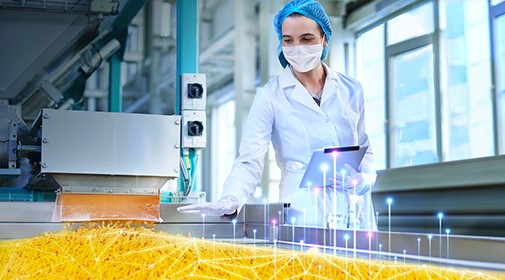Agribusiness continues to be a major player in the US economy, contributing $1.109 trillion to national GDP in 2019. Global agribusiness revenue is expected to hit $10.2 trillion as the global economy rebounds from the pandemic slowdown.
Over the past generation, the food business grew by consolidating into large producer/distributor operations, centred on creating a commodity-oriented distribution system. More recently technology and changing food habits are fuelling the rise of specialised, integrated, and value-added production and distribution networks. Some in the business may view this shift as a challenge, but to those who can embrace tech-enabled forward thinking, rebuilding supply chains is a growth opportunity.
Niche products and new categories, such as kombucha drinks and plant-based faux meats, are only the tip of the iceberg. The entire food supply chain needs a refresh, to become connected, transparent, efficient, and sustainable. These overarching goals are the same in other industries, which means there are lessons to be learned from other large industries already started down the road of creating more sustainable supply chains.
As a reminder, when we talk about a supply chain being “sustainable,” we mean a creation and distribution system that not only moves products to market quickly and profitably, but also reflects modern sensibilities regarding human and (in the case of agribusiness) animal dignity, fair labour practices, environmental responsibility, and built-in anti-corruption policies.
The recent book “Sustainable Food Supply Chains: Planning, Design, and Control through Interdisciplinary Methodologies” speaks directly to these challenges. Edited by Dr. Riccardo Accorsi and Dr. Riccardo Manzini of the University of Bologna, the study finds “the sustainable production and distribution of food is one of the most crucial problems … facing the world today.” Contributors to this book show how rising affluence drives more sophisticated eating habits: consumers want Bolivian quinoa, Belgian beer, Thai rice, and Spanish hams at their local grocery store as well as locally grown apples and lettuce. Other challenges addressed include how the global supply chain must offer a functional model of sustainable ecosystem planning; how food waste needs to be seen as a massive inefficiency instead of business as usual; and the need for systems thinking in the design of more resilient agribusiness supply chains. And, of course, to do all of this and more while making a profit, which is its own special kind of sustainability.
Virtual twin technology — normally associated with manufacturing or packaging design — is receiving attention for its ability to create and manage new, more sustainable supply chains. Diane Burgos and Dmitry Ivanov of the Berlin School of Economics and Law review how the pandemic impacted food supply chains, by creating a discrete-event simulation model based on virtual twin (sometimes referred to as digital twin) technology. They summarise: “We stress the importance of supply chain digital twins and end-to-end visibility along with resilient demand, inventory, and capacity management. The outcomes of our study can be instructive for enhancing the resilience of food retail supply chains.”
The virtual twin — and its sidekick the virtual thread — are metaphors to describe new technology for real-time production, operations, and supply chain management.
The virtual thread is the communications framework, an important element of Industry 4.0, which has six key purposes:
- IT-enabled mass customisation
- Automatic and flexible adaptation of the production chain
- Tracking and self-awareness of parts, products, and processes
- Improved human-machine interaction such as cobots and smart production equipment
- Production optimisation via the Internet of Things (IoT)
- New types of services, business models, and value chains.
A virtual thread offers a connected and automated data flow for all assets throughout their life cycle. Products, production, and supply chain elements are all connected to get the right information to the right place at the right time.
The virtual twin is a digital model of all parts connected by the virtual thread, kept up-to-date so that it always shows the current state of all elements. The virtual twin is the user interface connecting all players with all information, existing as a single source of truth.
Information flows in two directions in these virtual models of production and distribution. If a new farm joins the (fictional) Organic Arabica Coffee Consortium of Costa Rica, it means there are new Internet of Things sensors in place at the farm collecting and receiving data, and a new entity in the virtual twin model of operations.
Software can provide the foundational framework for agribusiness supply chains to apply the real-time empowerment of the virtual twin. Such technology allows agribusiness companies and cooperatives to more efficiently identify, assign, and monitor their Key Performance Indicators (KPIs). Having a virtual twin in place allows scenario planning and provides instant access to data needed to respond to unexpected situations. The best way to manage disruption and improve global supply chain operations is to be able to re-plan with speed and confidence. That’s where virtual twin technology sets itself apart.

